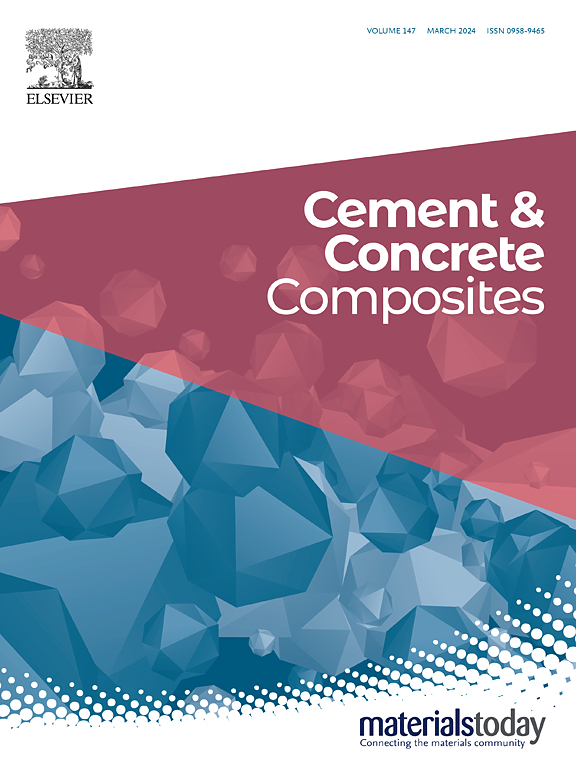高性能低碳水泥复合材料中再生碳纤维和生物炭的协同增强:建筑材料的可持续发展途径
IF 13.1
1区 工程技术
Q1 CONSTRUCTION & BUILDING TECHNOLOGY
引用次数: 0
摘要
生物炭作为胶凝复合材料的可持续增强物的整合已经成为建筑行业碳封存和生物质废物管理的双重效益战略。然而,过多的生物炭掺入往往会损害水泥基质的机械性能。本研究介绍了一种创新的、环保的方法,通过将生物炭(2%-10%的水泥替代)与再生碳纤维(1%-3%)协同结合,开发高性能、低碳的水泥砂浆。实验结果表明,生物炭的加入在降低流动性、延长凝结时间的同时,通过成核效应、内部固化、加速CO2扩散,提高了水泥的水化程度,促进了钙矾石、水合硅酸钙凝胶的形成和碳化过程。尽管抗弯强度有所提高,但生物炭诱导的孔隙率对抗压强度有负面影响。再生碳纤维的掺入抵消了这一限制,通过纤维桥接机制,与普通水泥基质相比,生物炭增强砂浆的抗压强度和抗弯强度分别提高了14%和62%。虽然观察到纤维和生物炭修饰的基质之间有很强的界面键,但增强效率随着生物炭用量的增加而降低。此外,纤维和生物炭的含量应限制在特定的量,以避免过度孔隙和由此导致的强度损失。此外,在胶凝复合材料(10BC)中单独加入10%的生物炭,在抗压强度标准下提供了最有利的环境和经济性能平衡,实现了3.7 kg CO2当量/m3/MPa的减排,利润为10.3元/m3/MPa。通过在10BC砂浆中添加2%的再生碳纤维,可以进一步增强性能,在考虑抗压和抗折强度的情况下,将总排放量增加到41.1 kg CO2当量/m3/MPa,尽管经济效益会降低。这项研究不仅推动了低碳、高强度建筑材料的发展,而且为生物炭在建筑领域的大规模应用铺平了道路。本文章由计算机程序翻译,如有差异,请以英文原文为准。


Synergistic reinforcement of recycled carbon fibers and biochar in high-performance, low-carbon cement composites: a sustainable pathway for construction materials
The integration of biochar as a sustainable reinforcement in cementitious composites has emerged as a dual-benefit strategy for carbon sequestration and biomass waste management in the construction industry. However, excessive biochar incorporation often compromises the mechanical properties of cement matrices. This study introduces an innovative, eco-friendly approach by synergistically combining biochar (2 %–10 % cement replacement) with recycled carbon fibers (1 %–3 %) to develop high-performance, low-carbon cement mortars. Experimental findings reveal that while the biochar addition reduces fluidity and prolongs setting times, it enhances the cement hydration degree through nucleation effects, internal curing, and accelerated CO2 diffusion, promoting the formation of ettringite, calcium silicate hydrate gels, and the carbonation process. Despite improvements in flexural strength, biochar-induced porosity negatively impacts compressive strength. The incorporation of recycled carbon fibers counteracts this limitation, significantly enhancing the compressive and flexural strengths of biochar-augmented mortars by up to 14 % and 62 %, respectively, compared to plain cement matrices, through fiber bridging mechanisms. Although a strong interfacial bond is observed between the fibers and the biochar-modified matrices, the reinforcing efficiency is diminished with higher biochar dosages. Furthermore, the fiber and biochar contents should be limited to specific amounts to avoid excessive porosity and the resulting strength loss. Additionally, incorporating 10 % biochar alone into cementitious composites (10BC) provides the most favorable balance of environmental and economic performance under compressive strength criteria, achieving an emission reduction of 3.7 kg CO2 eq./m3/MPa and a net cost of 2.4 CNY/m3/MPa. Further enhancement is possible by adding 2 % recycled carbon fiber to the 10BC mortar, increasing the total emission reduction to 41.1 kg CO2 eq./m3/MPa when both compressive and flexural strengths are considered—albeit with an increase in economic costs. This study not only advances the development of low-carbon, high-strength building materials but also paves the way for the scalable application of biochar in the construction sector.
求助全文
通过发布文献求助,成功后即可免费获取论文全文。
去求助
来源期刊

Cement & concrete composites
工程技术-材料科学:复合
CiteScore
18.70
自引率
11.40%
发文量
459
审稿时长
65 days
期刊介绍:
Cement & concrete composites focuses on advancements in cement-concrete composite technology and the production, use, and performance of cement-based construction materials. It covers a wide range of materials, including fiber-reinforced composites, polymer composites, ferrocement, and those incorporating special aggregates or waste materials. Major themes include microstructure, material properties, testing, durability, mechanics, modeling, design, fabrication, and practical applications. The journal welcomes papers on structural behavior, field studies, repair and maintenance, serviceability, and sustainability. It aims to enhance understanding, provide a platform for unconventional materials, promote low-cost energy-saving materials, and bridge the gap between materials science, engineering, and construction. Special issues on emerging topics are also published to encourage collaboration between materials scientists, engineers, designers, and fabricators.
 求助内容:
求助内容: 应助结果提醒方式:
应助结果提醒方式:


